Advertisements
Advertisements
Question
Distinguish between a real and a virtual image.
Solution
| Real image | Virtual image |
| 1. A real image is formed due to actual intersection of refracted (or reflected) rays | 1. A virtual image is formed when the refracted (or reflected) rays meet if they are produced backwards |
| 2. 2 A real image can be obtained on a screen | 2. 2. A virtual image cannot be obtained on a screen |
| 3. 3. A real image is inverted with respect to the object. | 3. 3. A virtual image is erect with respect to the object |
APPEARS IN
RELATED QUESTIONS
The diagram below shows a lens as a combination of a glass slab and two prisms.
- Name the lens formed by the combination.
- What is the line XX’ called?
- Complete the path of the incident ray AB after passing through the lens.
- The final emergent ray either meets XX’ at a point or appears to come from a point on XX’. Label it as F. What is this point called?
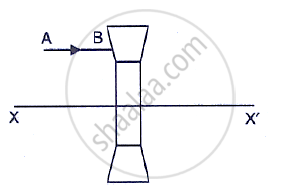
A ray of light after refraction through a lens emerges parallel to the principal axis of the lens. The incident ray either passes through ______.
Study the diagram shown in Fig. 5.56
Where is the image formed?
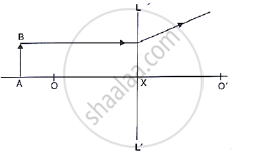
Study the diagram shown in Fig. 5.56
what are the two other characteristics of the image?
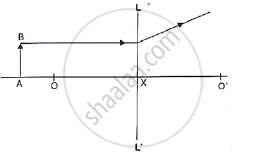
What type of lenses are used in spectacles worn by an old lady for knitting?
In the following diagram , the object and the image formed by the respective lenses are shown. Complete the ray diagram, and locate the focus. Find the focal length of the lens.
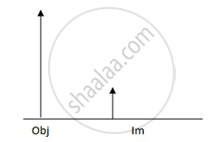
Fig. shows two rays of light Op and OQ coming from an object at the bottom of a pond, incident on the water surface.
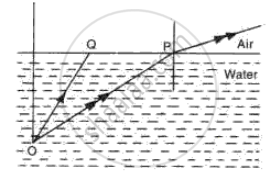
(a) Mark on the diagram
(i) The angle of incidence of ray OP,
(ii) The angle of refraction of ray Op,
(iii) The position of image of the object as seen from above.
(iv) An approximate path of the ray OQ.
(b) Explain, why do the rays of light change directions on passing from water to air.
(c) A fish in water sees everything outside the water by rays of light entering its eye in a small cone of light. Draw a diagram and explain how does this happen.
(a)A ray of light is incident at 45° on the face of
(i) A rectangular block of glass.
(ii) A 600 glass prism.
(b) Draw a sketch showing how the ray of monochromatic ray of light passes through glass in each case.
(c) With the aid of a diagram, explain how the face of a right angled prism may totally reflect incident on it.
(d) A thick plane mirror produces several faint images in addition to a prominent one. Draw a ray diagram showing how reflection and refraction produce all these images.
(e) Fig. represents a stone S at the bottom of a pond of water. Using the two rays, as shown, complete the ray diagram to show where the image of the stone appears when viewed from E.

(f) What is a''mirage'? Explain with the help of a diagram.
(g) A man observes the bottom of a swimming pool of 3 m depth. If the refractive index of water is 1.3, what is the apparent depth of water?
(h) When a ray of light undergoes refraction through a glass slab and when it emerges it is displaced laterally (Fig). What are the factors on which the lateral displacement depends?
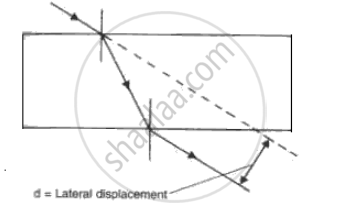
(i) Fig. shows three rays of light OA, OB and OC passing from water to air, making angles 490, 410 and 350 with the horizontal surface respectively. Draw an approximate path of the emergent ray for each. (Critical angle of water is 490.)
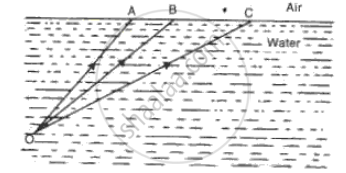
A lens forms the image of an object placed at a distance of 45 cm from it on a screen placed at a distance 90 cm on the other side of it. Name the kind of lens.
Draw a ray diagram to show the image formed by a convex lens when the object is placed between F and 2F.
